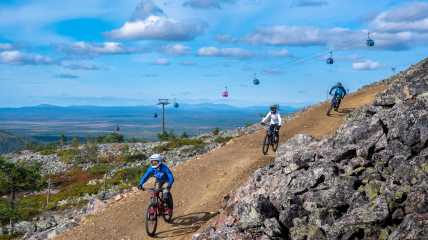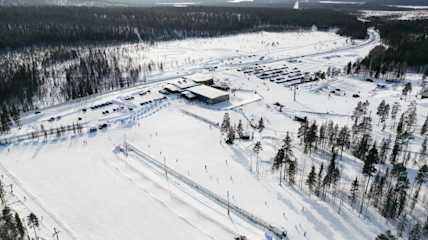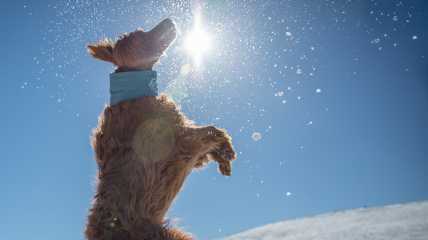
The carbon footprint of buildings and facilities reduced through renewable energy and building automation
Levi Ski Resort has been using geothermal energy and surplus heat to warm indoor spaces for a long time now. The resort uses surplus heat generated by snow gun compressors to warm indoor places.
We asked Antti Rauhala, Property Manager at Levi Ski Resort, how the energy efficiency of Levi properties has developed over the years to where it is now. We also discussed the next steps in development.
– We have been investing into the development of energy efficiency of our properties for a long time, just as we develop all the areas of our environmental work. Property heating, air conditioning and other building services play a significant role in shaping the carbon footprint of any business. For us, properties account for about 30 percent of all electricity consumption, Antti Rauhala tells us.
– Due to our long-term environmental efforts, we became the first ski resort in the Nordic countries to earn the ISO 14 001 environmental certificate. The certificate obliges us to keep on developing our operations, based on the principle of continuous development. The standard requires concrete actions; promises are not enough, Antti adds.
POWERED BY RENEWABLE ENERGY
In the construction of new properties at Levi Ski Resort, the principle is that they should all be able to utilise renewable energy as much as possible.
– The South Point properties, built in 2014, are able to use geothermal energy and surplus heating for their needs. The same applies to West Point properties, commissioned during the 2019 season; they utilise geothermal heating, says Antti.
In 2018, Levi Ski Resort received the ISO 14001 environmental certification, initiating actions to significantly reduce carbon emissions.
- At that time, a study was conducted on the adoption of geothermal energy, its benefits, and maximum capacities. Enhancing energy use was also supported by a plan to utilize waste heat from snowmaking in the gondola building, says Jouni Palosaari, CEO of Levi Ski Resort.
In 2019, a preliminary study was initiated to examine the energy efficiency of the gondola lift building and the Competition and Training Center. These buildings were then served by an approximately 20-year-old oil boiler plant. The study revealed that the snowmaking system's air compressors produce a lot of waste heat during the snowmaking season. It was decided to replace the old oil boilers with heat pumps that utilize this waste heat, improving the buildings' energy efficiency.
During the summer renovation of 2023, more comprehensive break areas for competitors were expanded behind the maintenance building, and the Gondola Restaurant was renovated. In 2024, the geothermal project was advanced by constructing a large geothermal field with 36 wells. This complements the energy efficiency of Levi Ski Resort and is the most significant step towards our goal of using sustainable energy sources in all properties.
- Levi Ski Resort has been involved in Metsähallitus' TOBE Low Carbon project, which focuses on actions that reduce business's carbon footprint. Naturally, real estate has a role to play in that, Antti says.
SIGNIFICANT ENERGY REDUCTIONS ACHIEVED BY BUILDING AUTOMATION
Property manager Antti Rauhala says that the building automation system that was installed in 2017 has been an important factor in improving energy efficiency. Majority of the energy savings comes from the operating times of the ventilation system. Previously, air conditioning could only be operated at either full power or half power, adjusted on the basis of customer volume.
– Thanks to the automation technology we are able to adjust air conditioning more accurately. Reduced operating times of the ventilation system have brought significant energy savings. It also improves comfort, as the ventilation now responds to the number of people on the premises, says Antti.
– We actively collect data from all the systems we use. For example, we have been monitoring electricity consumption of our properties under different weather conditions for more than a decade. This helps us optimise energy consumption, in a similar way as the data-driven snowmaking helps us save water and energy. Each of our service technicians uses a mobile application, with which they can update energy and water consumption monitoring data into our electronic logbook. The data from the logbook can be accessed by other systems and exported to Excel, Antti continues.
– The weather, the number of visitors and the number of operating days, all affect our total energy consumption. Consequently, different years are not directly comparable. However, when comparing the annual energy consumption of our facilities from before and after the building automation system was introduced, energy consumption has reduced by about one-fifth by a rough estimate. This has been a significant leap forward, Antti sums up.
Did you know that Levi is the first ISO 14001 certified ski resort in the Nordic countries? Learn about the different dimensions of sustainability at Levi Ski Resort here. Additionally, read about the development of resource and energy efficiency in snowmaking, our waste sorting efforts and the optimisation of the electricity consumption of slope lighting.







